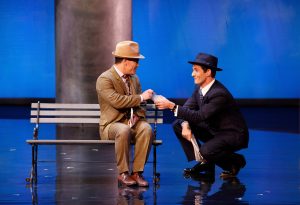
By Rosie Rogers
Florida Grand Opera’s production of Gregory Spears’s 2016 opera Fellow Travelers told a Lavender Scare love story with a sweetly melancholic score. With direction from Peter Rothstein, the smooth set changes produced a constant motion well-matched to the minimalism of the orchestra.
Starring Hadleigh Adams and Andres Acosta as the two romantic leads, Hawkins “Hawk” Fuller and Timothy Laughlin, the production, which played April 23-28 at the Lauderhill Performing Arts Center in Lauderhill, succeeded in creating an immersive and engaging experience.
A simple and constantly changing set complemented the unceasing gentle motion of the score. In the opening scene, brutalist concrete columns and a suspended leafy branch cast dappled shadows across a wooden bench. This backdrop was quickly transformed as costumed members of the cast walked across stage bringing tables, desks, and beds, on and off the set to move quickly between scenes without interruption. These smooth scene changes added to the fluid feeling of the production.
A suspended screen occasionally separated the stage to allow for simultaneous action. This was particularly effective in Scene 14, when Tim relays his confession to a priest. As Tim lay in bed with Hawk, Christopher Humbert Jr. sits to the side as a disappointed priest with a powerful bass. The screen functions literally as a confession screen, while also splitting the stage to give a visual representation to Tim’s reflection.
When Tim visits St. Peter’s Church after his first night with Hawk, an enormous crucifix commanded attention and literally overshadowed the scene. Although I found this set a little heavy-handed, the stark lighting created a dark drama when Tim left the church.
The staging worked particularly well in Scene 6, when the cast divided itself into shifting pairs and smaller groups to play out the drama of a Christmas party. Some froze, then moved and regrouped as the music and narrative focus jumped. The cast created a jovial, tipsy energy shot through with a hectic thread of anxiety. Another affecting moment was Scene 11, when Tim and Hawk meet on an old rooftop. Dark reflective light created a moody atmosphere for their post-breakup conversation.
Amanda Olea played Miss Lightfoot as flighty and casually cruel, whose high spirits were reflected in her clear and glittery soprano. Adelaide Boedecker shone as Mary Johnson, and was particularly excellent in her duets with both male leads. Her smooth tone paired beautifully with both Acosta and Adams, and she navigated melismatic passages with ease and acrobatic grace.
Acosta’s youthfully exuberant tenor made a beautiful contrast with Adams’s more mature, rich sound. Their moments of singing together were well-matched, and their voices in combination stood out above the pulsing orchestra. While Acosta’s voice occasionally strained, this emphasized Tim’s youth and intensity of feeling, and the significant placement of this sound ultimately served the narrative.
The body language of the two leads similarly differentiated their characters. Acosta played up Tim’s uncertainty by bouncing a bit on the balls of his feet and swinging his arms self-consciously, while Adams strode confidently around the stage. Together they created a captivating chemistry with palpable tension from the first scene to the last. Placed in Tim’s spartan, intimate bedroom set, the pair created a sexiness that managed to be both believably awkward and extremely artful at once.
Conducted by Emily Senturia with grace and clarity, the orchestra created a wavelike backdrop for drama, which made any pauses in rhythmic movement significant. As they held a chord when the two leads first locked eyes, the music created a moment of suspended time showing the importance of the moment. Spears’s melismatic vocal writing was beautiful and emotional, and moments of medieval harmony in the woodwinds added color to the sameness of slow-shifting minimalism.
Although the score lacks much differentiation and runs together, this production’s thoughtful staging and excellent acting avoided monotony and instead created intentional fluidity. The constant motion of both score and story made the production captivating and emotional.